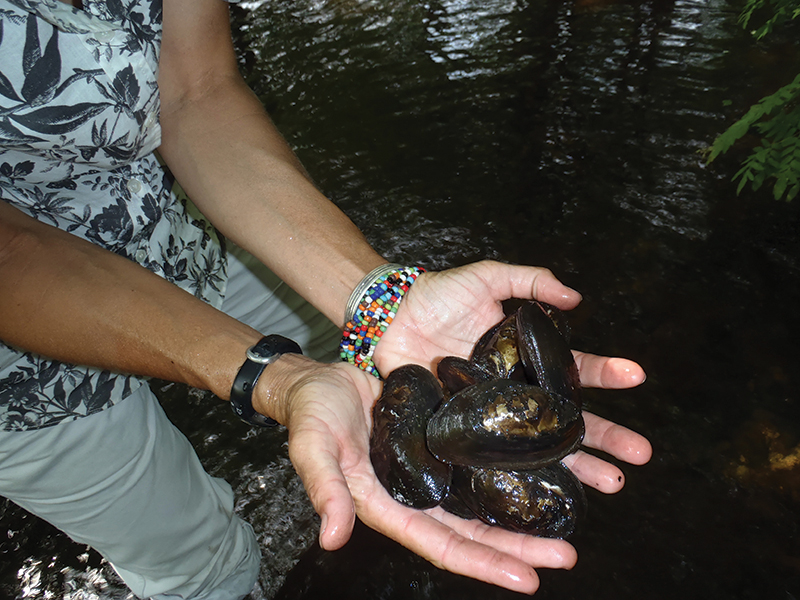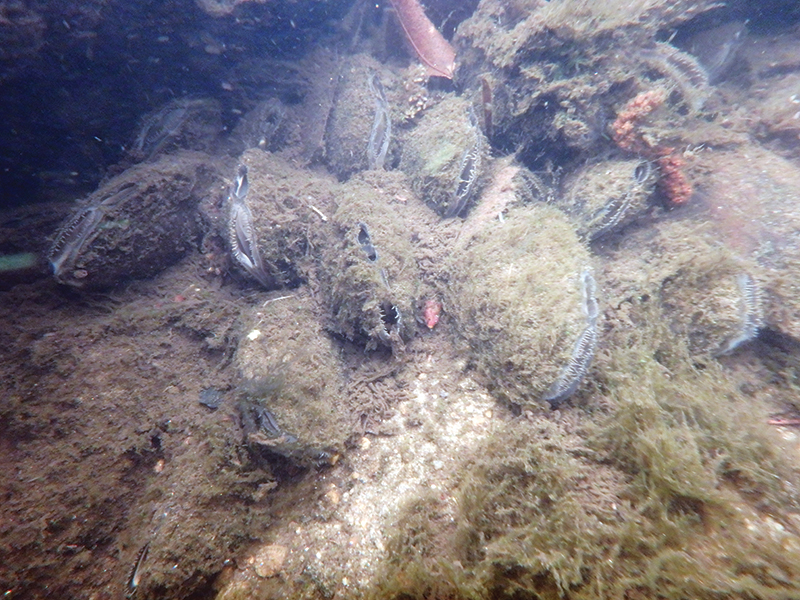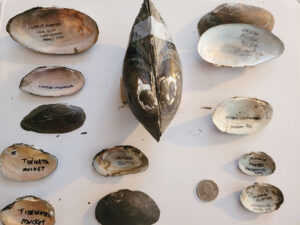
These mussels were hand-collected above a dam that was being removed and were resettled in habitat that was out of harm’s way.

Rivers Have Mussels, Too!
It’s not just fish underwater
Story and Photos by Steve Gephard and Sally Harold
Below the surface, when we’re snorkeling, we are usually focused on fish. In previous articles we’ve talked about Sea Lamprey nest building, anadromous fish migration, and American Eels slithering over dams, but some of the fascinating inhabitants in our streams are not fish; they are invertebrates: freshwater mussels.
Along the seashore we’re familiar with ribbed mussels and blue mussels (which make a delicious meal), but unlike these saltwater mussels, the freshwater cousins do not taste good nor do they form large rafts or adhere to hard substrate like dock piers and rocks. Rather, they live partially submerged in the stream bottom where, during the cold winter months, they hibernate completely buried. As the water warms in the spring, they work their way up through the mud or from between the rocks until they are partially exposed and are able to open their hinged shells slightly to begin to feed. Mussels suck in enormous amounts of water (a single mussel can filter 15 gallons of water a day) and filter out microscopic plants and animals (plankton). They can bioaccumulate contaminants such as heavy metals, pesticides, and bacteria in their flesh. Healthy populations of mussels can be credited with improving water quality.
Worldwide there are only 890 species of freshwater mussels, 302 of which are found in North America. Our Connecticut River watershed is home to relatively few species of mussels—only twelve. States south of the extent of glaciers—Tennessee for one—have a much greater diversity of mussel species. Tennessee has 130!
It’s estimated that 70 percent of mussel species are imperiled. This is true across North America and across the watershed. Mussels are the most endangered group of animals in the nation. One species in our watershed, the Dwarf Wedgemussel, is on the federal endangered species list, and many others are listed by one of the four states as threatened or endangered.

Mussels such as these Eastern Elliptios can be found in dense colonies on the bottom of streams. The gap between their shells allows them to filter feed while pumping in gallons of water a day.
Two major factors affect mussel survival. The first is habitat degradation, mostly due to sedimentation caused by poor land-use practices or storm water runoff, but also because of dams. Many species need rocky-bottomed streams, and too much sediment can smother the habitat and make it unsuitable. The second factor may surprise you: it’s fish. Mussels and fish have a commensal relationship. That is, the mussel benefits, and the fish is neither harmed nor helped. During the spawning season, the male mussels send sperm out into the water column; females intercept the sperm and draw them into their bodies to fertilize their eggs. The fertilized eggs develop into larvae, known as glochidia, which have tiny, clamp-like appendages. Next, the female mussel waves its mantle—a fleshy part of its body—to attract fish. Their mantles have evolved to look like a worm, a small fish, or some other delectable fish food. As a fish moves in to chomp down the meal, the mussel spews glochidia into the fish’s mouth, and as the glochidia pass over the fish’s gills, the larvae clamp down and attach to the gills, similar to the way a tick holds onto our skin. The glochidia feed and grow while hitchhiking on the fish, and they go wherever the fish goes. After a week or two, they drop off, settle into the streambed, and start a new colony of mussels.
Some mussel species are generalists and care little about which species of fish transports them, while other mussels have very specific targets and use only one or two species of fish. For example, the Alewife Floater specializes in Alewife but clearly also uses Blueback Herring and probably American Shad. The distribution of the mussel’s host species determines the distribution of the mussel. Many of the host fish are diadromous (migratory) fishes that traveled long distances in the watershed. Historically, these fish and their hitchhiking glochidia were widespread throughout the watershed, however, during the past 300 years, the distribution of those fish has been severely truncated due to the construction of dams.
The construction of the Holyoke Dam in 1840 meant that fish carrying glochidia that could once reach St. Johnsbury, Vermont, could no longer get upstream of Holyoke, Massachusetts (a distance of 173 miles). More recently, the construction of fishways at the large dams and the removal of dams on tributaries have restored mussel transport, allowing migratory fish to carry larvae to some upriver habitat within our watershed, but the abundance and distribution of these animals is still not what it used to be.
The Tidewater Mucket uses Striped Bass and perhaps Alewife as hosts and is found only downstream of the Holyoke Dam. The Holyoke Fishlift does not pass Alewife and only a few Striped Bass.

The insides of mussel shells offer many clues as to which species they belong. These are some of the species found in the Connecticut River watershed. Shells come in a variety of sizes, shapes, and colors.
The Eastern Elliptio prefers the American Eel as its host and is found in the main stem as far north as Pittsburg, New Hampshire, and in practically every tributary drainage. Eels make great hosts since they are habitat generalists and can wriggle over dams and other barriers that block other migratory fish.
Only Connecticut and Massachusetts host all twelve of the native species found in the watershed, but the numbers of each of the species can be very low. For example, only three Yellow Lampmussel have been found in Connecticut. It may be even rarer than the Dwarf Wedgemussel in the river. Only nine species are found in Vermont and New Hampshire.
Even with stream restoration and dam removal efforts, mussel populations are still at risk. Mussel species are not well known because few people snorkel rivers! Often, if they are found, they are misidentified as freshwater clams or simply identified as a mussel. Identification to the species level can be challenging. Live mussels (closed shells) can be very hard to identify unless you’re the estimable Ethan Nedeau of Massachusetts, a mussel expert who has performed underwater surveys of countless miles of Connecticut River watershed habitat. For most of us, it is easier to identify the species by an open shell (dead mussel), using characteristics such as the number of lateral and pseudocardinal “teeth” found inside the shell. But it is unethical and contrary to good conservation practices to kill a mussel just to identify the species, so learning the external features is critical for naturalists.
What we have learned during dam removals and other stream restoration projects is that we must look for mussels and protect them. While a slow draining of the pond above the dam can allow fish to escape, the mussels don’t have the ability to follow the water and must be relocated by hand. If you wait too long, many will burrow deeper into the exposed sediment, as if trying to weather a drought. During our projects, when there are mussels present, we plan a rescue strategy in which many hands collect exposed mussels and put them into water-filled coolers to be transported to stable upstream habitat or to another stream.
It may come as a surprise to learn that these small mollusks are long-lived. The Eastern Pearlshell has been reported to live up to 132 years! In one stream where the two of us have snorkeled there are dozens upon dozens of Eastern Pearlshell in the space of about 400 square feet. This same mussel bed has been observed for over forty years. When we see them it’s as if we’re seeing old friends! The long lifespan of mussels may explain why some species still persist above dams even after decades without their preferred host being able to reach that same habitat. Their longevity may make us complacent, but without the host fish to carry the glochidia (the larva or young of a mussel), the bed will eventually die out. This is why it is so important to reconnect stream habitat for migratory fish. In doing so, we can rescue declining populations of mussels—and who knows how many other “under-the-radar” species.
Steve Gephard is a fisheries biologist. He recently retired after 40 years with the Connecticut Department of Energy and Environmental Protection Fisheries Division. He continues to work in the field as an independent consultant.
Sally Harold is an independent consultant for various fish passage and habitat restoration projects. Previously she worked as a fish restoration project manager for The Nature Conservancy.

